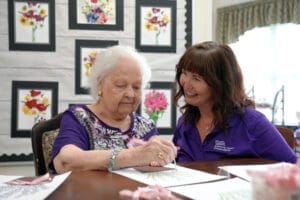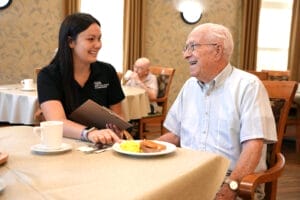More and more often, today’s assisted living communities are relying on technological advances to help improve quality of life for residents. Technology not only increases resident care and satisfaction, but it also enriches the lives of both the residents and their families.
Today, seniors are more tech-savvy than ever before. According to a study from the Pew Research Center, among adults age 65 and older, 30 percent of them own a smartphone, 32 percent of them own a tablet and 55 percent own a computer or laptop. These devices are now part of our daily lives, and can be used not only to keep us connected to others, but also to improve our physical and mental health.
The Best Technology for the Elderly in Assisted Living
Smartphones, tablets and computers are not the only types of tech items being used at assisted living communities. Technology is continually changing the way we live, keeping us healthier, living longer, and staying engaged with loved ones and our communities often. In fact, research from the Consumer Technology Association (CTA) reveals that the market for aging technology is expected to grow from 2015’s $24.4 billion market opportunity to $42.7 billion by the year 2020. Through personal health technology or elderly monitoring devices, the staff at an assisted living community are able to stay more closely connected to the residents, keeping them as safe and as healthy as possible.
Some of the main types of technology for the elderly that is regularly used in assisted living communities throughout the country include:
Wireless internet. A 2012 study found that 90 percent of today’s retirement communities are utilizing some type of wireless technology, with 36 percent of those communities providing social networking access specifically for the residents.
Tablets or iPads. Tablets offer an inexpensive way for residents to play games that promote cognitive wellness, read books, listen to music and more.
Smartphones. Smartphones can be easier for a senior to use than a typical cellphone, as the screens and buttons are usually larger. Plus, apps can be downloaded to smartphones that can perform important functions, like providing GPS location data and medication reminders. Seniors can also use smartphones to connect with loved ones who are not geographically nearby, even allowing them to see them “in person” by using Skype or Facetime.
Video games. Studies have found that older adults who play video games are healthier both physically and emotionally. While many of the benefits of video games contribute to better cognitive functioning, gaming systems like Nintendo’s Wii also help improve mobility among the residents.
Health tracking devices. Wearable fitness trackers help monitor the activity levels of residents, and also can help encourage healthy eating and exercise.
Nurse call technology. A wireless system allows residents to call for assistance from the bedside or bathroom should they need help. This technology can also include elderly monitoring devices like surveillance cameras, door or window alarms, location data to locate a resident in need more quickly, medication reminders and more.
American Senior Communities has a variety of assisted living options available at our locations statewide. Contact us today to request more information.



